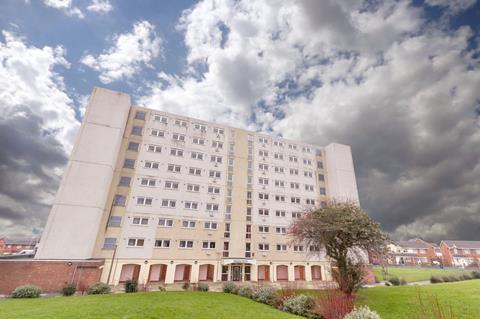Advanced has supplied its EvacGo evacuation alert system to three social housing tower blocks in Halewood, Merseyside

Merseyside housing association, Livv Housing, has retrofitted an emergency evacuation alert system into three of its nine-storey tower blocks in Halewood, north England.
Manufactured by fire protection solutions company, Advanced, EvacGo systems have been installed in Woolton Views, The Fairways, and Ashton Park on Sherbourne Avenue.
ABM Fire & Security undertook the supply and installation in each of the 48-flat blocks. The systems installed feature a four-loop, eight-zone evacuation alert panel, which is housed inside “robust”, security-rated Gerda enclosures meeting the STS 205 class BR2 security rating.
This is said to minimise tampering by restricting access to fire and rescue service personnel only, who can access the controls using a patented key (stipulated in the BS 8629 code of practice). Visual alarm devices and interfaces have been installed in all 144 flats to ensure that hard-of-hearing and deaf residents are kept safe and informed.
Installation of evacuation alert systems is now mandatory in all new build residential apartment blocks over 18 m, with Part B (Fire Safety) of the building regulations in England offering guidance. However, for all other new build and retrofit projects, complying with BS 8629 is seen as best practice. BS 8629 Code of Practice sets out the criteria for the design, installation, commissioning, and maintenance of evacuation alert systems for use by fire and rescue services in England and Wales.

Tony Cahill, executive director-property at Livv Housing Group said: “When we were selecting an evacuation alert system for the three tower blocks, it was essential that it met the criteria for BS 8629. Advanced’s EvacGo is already installed in all of our other tower blocks and it ticks all the right boxes for us to meet best practice and to protect our customers in the event of a fire.”
According to the manufacturer, all of the company’s evacuation alert systems are manufactured to reflect each building’s evacuation zones, allowing the fire services to control evacuation floor by floor according to the severity and location of the fire.
Vital in helping fire and rescue services inform residents of a change in evacuation strategy during an incident, the guidance states that the evacuation alert control system should be installed where a ‘stay put’ policy is in force — so that it can be used to facilitate a timely and ordered evacuation for all residents.
According to the manufacturer, it must be standalone, with its only function being to assist fire and rescue services in the evacuation of the building.
Shaun Scott, emergency evacuation systems application engineer at Advanced, said: “Following the Grenfell Tower enquiry and the increased awareness of the importance of effective fire evacuation, we have seen an increasing number of housing associations and landlords installing an EvacGo system. While the Building Regulations make evacuation alert systems mandatory in new residential buildings over 18m, we’re finding that, like Livv Housing Group, many landlords of smaller buildings or those being retrofitted, are keen to meet best practice.”











No comments yet